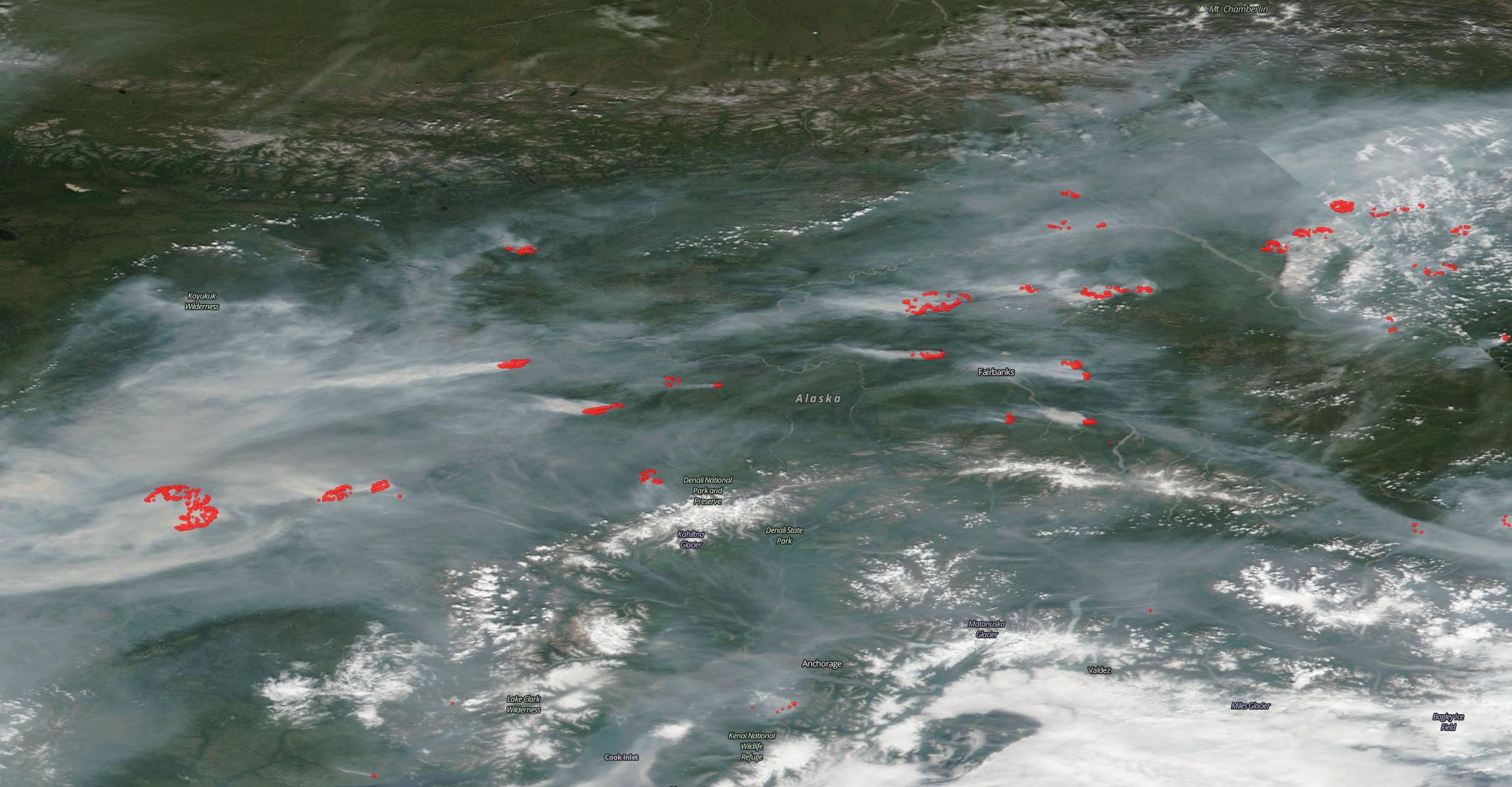A big fire season in Alaska fits the pattern across a warming Arctic
More than a million acres have already burned in Alaska, putting the state on track for one of its biggest fire seasons ever.

With more than 1.6 million acres burned by Alaska wildfires as of July 15, the 2019 fire season is on track to become one of the state’s biggest fire seasons since the 1990s — and it is part of fiery trend in the far north.
The 1.5 million-acre mark makes the 2019 season the third-biggest fire season for this time of year since 1990, and significant growth is likely, said Rick Thoman, a climate specialist at the Alaska Center for Climate Assessment and Policy.
“Given where we are at this time in the season, it would seem that over 2 million acres is more likely than not,” he said.
[Air quality plummets as wildfire smoke hits Alaska’s cities]
This year will be the eighth in Alaska since 2000 with more than 1 million acres burned, according to statistics kept by the Alaska Division of Forestry.
It used to be that million-acre fire seasons occurred about once a decade in Alaska, Thoman said.
“That’s all changed now,” he said. “It’s not that every season is a big season. It’s just that big seasons come more frequently.”
Alaska’s widespread fires this year, in locations ranging from the currently drought-stricken rainforest of the southeast panhandle to the tundra above the Arctic Circle in northwestern Alaska’s Chukchi Sea coastal region and on the North Slope, are part of an Arctic-wide pattern.
[Hikers warned as Greenland wildfire burns out of control]
In Russia’s Sahka Republic, the number of June fires was deemed “unprecedented” by Mark Parrington, a senior scientist at the European Centre for Medium-Range Weather Forecasts.
Carbon released to the atmosphere in June from those and other fires above the Arctic Circle, including those in Alaska, was calculated the ECMWF’s Copernicus Atmosphere Monitoring Service to be 50 megatonnes. That is more than the combined carbon releases of all June wildfires in the Arctic from 2010 to 2018, according to the calculations. It is also equivalent to Sweden’s fossil fuel carbon-dioxide emissions for the entire year of 2017, according to Parrington’s calculations.
The fiery summers in Alaska and Russia are related, Thoman said.
“The big fires in both Alaska and Russia, they’re directly tied to that bubble of hot air — the big high that has lasted in both places,” he said.
The same hot system has fueled fires in Canada’s Yukon, too. Dozens of active fires are spread across the southern half of the territory, according to the Yukon government. The fires have producing smoke that is hindering traffic on the Klondike Highway and pouring into southeast Alaska, resulting in air quality advisories there.
In Alaska, smoke has proved a health and safety hazard. Air quality advisories in various parts of the state, and especially in the interior region, have warned of conditions that can range into the “hazardous” category, meaning that any outdoor activity is dangerous to people’s health. In Fairbanks, a hospital set up a clean-air respite room, with around-the-clock service for the public. Smoke has hampered traffic on highways, in places forcing authorities to limit vehicles to single lanes guided by pilot cars. And on the Kenai Peninsula south of Anchorage, three people were killed on June 28 when their plane was flying in an area enveloped by thick wildfire smoke. At the time, smoke “reduced visibilities in all directions,” said a preliminary National Transportation Safety Board report issued on July 11.
Scientific studies show how the far-north fires are linked to climate change.
A study of lakebed cores, tree rings and other evidence that tracked several centuries of interior Alaska fire activity reveals that wildfires and summer air temperature began a coupled upward trajectory at the beginning of the 20th century, according to a study published earlier this year in the journal Landscape Ecology.
“It looks like there’s kind of this switch that happens around 1900,” said Tyler Hoecker of the University of Montana, who authored the study, along with Philip E. Higuera, also of the University of Montana.
Their study examined traces of past fires and past weather going back to the year 1550. That physical evidence showed that prior to 1900, big fire years and very warm temperatures occurred fairly randomly, at least when evaluated on a longer-term decadal scale, Hoecker said.
The physical evidence also showed that biomass burning and the percent of sites burned reached their highest levels in the decades since 1980, said the study.
Since big fires can change the vegetation mix – with deciduous hardwoods replacing spruce, or even grasslands replacing trees – there may eventually be a limit to future fires, Hoecker said.
“In theory, there’s some point at which there isn’t fuel left to burn on the landscape,” he said.
But even treeless tundra is more prone to burning than it was in the past, according to other studies.
In Alaska, tundra fire acreage has increased significantly over the past half century, said a 2012 study led by wildfire expert Adrian Rocha of the University of Notre Dame. The study, published in Environmental Research Letters, warned that “a majority of tundra ecosystems are prone to burn given the right environmental conditions,” so fire projections should include tundra as well as forest ecosystems.
Arctic-wide, analysis of tundra fires from 2001 to 2015 found that intensity correlated with heat and lack of moisture, and not only in summer. Even winter conditions, if warmer and drier than normal, influenced intensity of tundra fires in the summer months, said the study, published last year in Environmental Research Letters. The study, by University of Northern Iowa scientists, was the first pan-Arctic examination of tundra fires and how climate affects them.